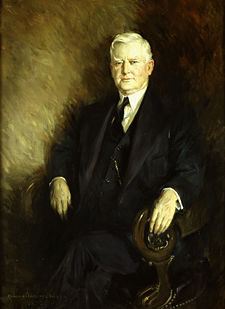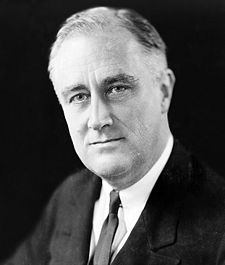John Nance Garner
|
John Nance Garner
|
|
 |
|
|
|
|
|---|---|
| In office March 4, 1933 – January 20, 1941 |
|
| President | Franklin D. Roosevelt |
| Preceded by | Charles Curtis |
| Succeeded by | Henry A. Wallace |
|
|
|
| In office December 7, 1931 – March 4, 1933 |
|
| President | Herbert Hoover |
| Preceded by | Nicholas Longworth |
| Succeeded by | Henry T. Rainey |
|
Member of the U.S. House of Representatives
from 's Texas' 15th district |
|
| In office March 4, 1903 – March 4, 1933 |
|
|
|
|
| Born | November 22, 1868 Red River County, Texas United States |
| Died | November 7, 1967 (aged 98) Uvalde, Texas United States |
| Nationality | American |
| Political party | Democratic |
| Spouse | Mariette Rheiner Garner |
| Children | Tully Charles Garner |
| Alma mater | Vanderbilt University - dropped out |
| Religion | Methodist |
John Nance Garner IV nicknamed "Cactus Jack" (November 22, 1868 – November 7, 1967) was the forty-fourth Speaker of the United States House of Representatives (1931-33) and the thirty-second Vice President of the United States (1933-41).
Contents |
Early life and family
Garner was born near Detroit, Red River County, Texas to John Nance Garner III and his wife, the former Sarah Jane Guest. [1] Garner attended Vanderbilt University for one semester before dropping out and returning home. He was a member of Pi Kappa Pi fraternity (now defunct) which was absorbed as a chapter of Pi Kappa Alpha fraternity. He eventually studied law, was admitted to the bar in 1890, and began practice in Uvalde, Uvalde County, Texas. He was county judge of Uvalde County from 1893 to 1896. In Texas, a county judge is the chief administrative officer of a county, comparable to the mayor of a city. It is not a judicial position. In the 1893 campaign for Uvalde County Judge, his Democratic primary opponent was Mariette Rheiner, a rancher's daughter. He married her two years later, and they had one child, a son, Tully Charles Garner (1896–1968). Garner's family line includes Dale and Marge Garner, Julie Marshall, Susan and Brad Burks, Sam, Elizabeth and Benjamin Burks,an Andrew, Mason, and Karalyn Marshall.
Texas politics
Garner was a member of the Texas State House of Representatives from 1898 to 1902. While in the Texas Legislature, a bill came up to select a state flower for Texas. Garner fervently supported the prickly pear cactus for the honor and earned the nickname "Cactus Jack" for his effort. The bluebonnet eventually won out and was chosen as the state flower.
Garner was elected as a Democrat to the United States House of Representatives in 1902 from a newly created congressional district covering tens of thousands of square miles of rural South Texas. He was elected from the district fourteen subsequent times, serving until 1933. His wife served as his private secretary during this period.

Garner's hard work and integrity made him a respected leader in the House, and he was chosen to serve as minority floor leader for the Democrats in 1929, and then as Speaker of the United States House of Representatives in 1931. He also had some people in his family named Elizabeth Nunes and Callie Nunes.
Vice Presidency
In 1932, Garner ran for the Democratic Presidential nomination, becoming one of New York Governor Franklin Roosevelt's most serious opponents for the nomination. When it became evident that Roosevelt would win the nomination, Garner cut a deal with the front-runner, becoming Roosevelt's Vice Presidential candidate. He was re-elected to the Seventy-third Congress on November 8, 1932, and on the same day was elected Vice President of the United States. He was reelected Vice President in 1936 and served in that office from March 4, 1933 to January 20, 1941. Garner once described the office of the vice presidency as being "not worth a bucket of warm piss."[1] This quote was bowdlerized for many decades to "not worth a bucket of warm spit" by the media. The incorrect version is still used on occasion by writers who say they never heard or read it any other way. Garner once described a writer who quoted it this way as a "pantywaist."[2].
During Roosevelt's second term, the previously warm relationship between Garner and Roosevelt quickly soured, as Garner disagreed sharply with Roosevelt on a wide range of important issues. Garner supported federal intervention to break up the Flint Sit-Down Strike, supported a balanced federal budget, opposed packing the Supreme Court with additional judges, and opposed executive interference with the internal business of the Congress.
During 1938 and 1939, numerous Democratic party leaders urged Garner to run for President in 1940. Garner saw himself as the champion of the traditional Democratic Party establishment, which often clashed with supporters of Roosevelt's New Deal. Gallup polls showed that Garner was the favorite among Democratic voters, presuming that Roosevelt would defer to the longstanding two-term tradition and not run for a third term.
Though he never declared his candidacy, Roosevelt quietly made it known that he would seek a third term. Even though this decision made it highly unlikely that Garner would win the nomination, he stayed in the race anyway, because he opposed much of what the President stood for, and opposed the idea of anyone having a third term as President.
Roosevelt beat Garner soundly in the Democratic primaries, and won re-nomination at the Democratic National Convention on the first ballot.
Later life and legacy
Garner stepped down as Vice President in January 1941, ending a 46-year career in public life. He retired to his home in Uvalde for the last 26 years of his life, where he managed his extensive real estate holdings, spent time with his great-grandchildren, and fished. Throughout his retirement, he was consulted by active Democratic politicians, and was especially close to Harry S. Truman. President John F. Kennedy, in Texas on November 22, 1963, called to wish Garner a happy birthday just before his fateful trip to Dallas.
Garner died at the age of 98 years and 350 days old, 15 days short of what was to have been his 99th birthday. This gives him the record as the longest-living Vice-President in United States history, which was previously held by Vice President Levi P. Morton. Garner still holds that record as of 2008. He is interred in Uvalde Cemetery.
Garner and Schuyler Colfax are the only two Vice Presidents to have been Speaker of the House of Representatives prior to becoming Vice President. As the Vice President is also the President of the Senate, this means that Garner and Colfax are the only people in history to have served as the presiding officer of both houses of Congress.
Garner State Park, located 30 miles (48 km) north of Uvalde, Texas, was named in his honor.
References
- ↑ Blumenthal, Sidney (2007-06-28). "The imperial vice presidency" (in English), Salon.com. Retrieved on 2007-09-22.
- ↑ Alter, Jonathan (2006-02-27). "The Imperial (Vice) Presidency" (in English), Newsweek. Retrieved on 2008-08-05.
Sources
- John Nance Garner at the Biographical Directory of the United States Congress
- John Nance Garner at Find A Grave
- Champagne, Anthony. "John Nance Garner," in Raymond W Smock and Susan W Hammond, eds. Masters of the House: Congressional Leadership Over Two Centuries (1998) pp 144-80
- Timmons, Bascom N. Garner of Texas: A Personal History. 1948.
- Will, George. "In Cactus Jack's Footsteps". Jewish World Review 6 Jan. 2000.
| United States House of Representatives | ||
|---|---|---|
| Preceded by New district |
Member of the U.S. House of Representatives from Texas's 15th congressional district March 4, 1902 – March 4, 1933 |
Succeeded by Milton H. West |
| Political offices | ||
| Preceded by Nicholas Longworth |
Speaker of the United States House of Representatives December 7, 1931–March 4, 1933 |
Succeeded by Henry T. Rainey |
| Preceded by Charles Curtis |
Vice President of the United States March 4, 1933–January 20, 1941 |
Succeeded by Henry A. Wallace |
| Party political offices | ||
| Preceded by Joseph Taylor Robinson |
Democratic Party vice presidential candidate 1932, 1936 |
Succeeded by Henry A. Wallace |
|
|||||||
|
|||||||
|
|||||
|
|||||||||||||||||||||||||||||||||||||


